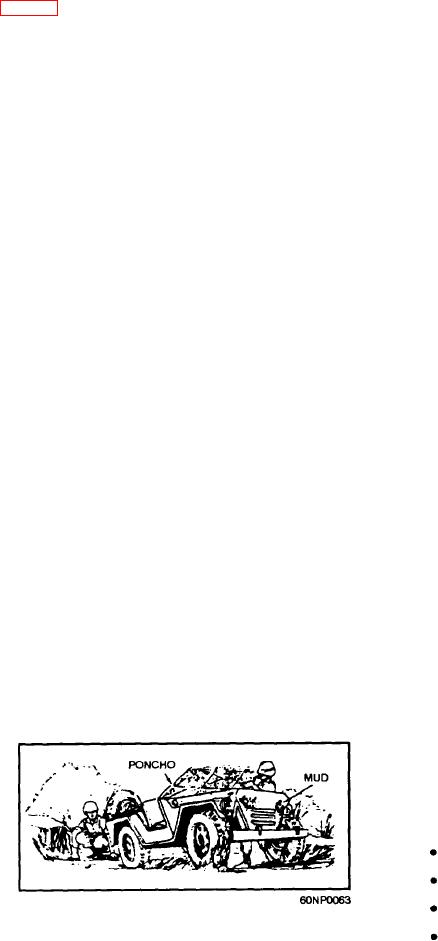
Firing Positions for Small
2. Smooth surfaces and objects (windshields,
Arms against Aircraft
headlights, and mirror) will reflect light and attract the
attention of the pilot. All shiny items should be
Except for the prone firing position, the basic
camouflaged or covered before the convoy moves out
firing stances of the rifleman remain the same. A
rifleman quickly learns that he or she wants to fire
If vehicles are not painted in a pattern to blend
from some type of cover or concealment; therefore,
with the terrain and to break the outline, you can use
you should look for a tree or a large rock to help
mud to achieve this effect.
support the weapon and provide some protection.
The M-60 machine gunner should also fire from a
Communications Security
protected position if possible. In a real emergency,
another Seabee can act as a hasty firing support for the
Communications equipment can be very useful
machine guns. The M-2 .50 caliber machine gun can
for controlling convoys. But it can also help enemy
only be used from the ring mount of dedicated
pilots find you. Use the radio when necessary, but be
vehicles. The following are tips for Small-Arms Air
brief.
Defense:
ACTIVE DEFENSE AGAINST
1. Fire at any attacking aircraft using all available
AIRCRAFT
weapons.
2. Fire at the nose of an aircraft.
The convoy commander may choose between an
active and a passive defense against the air threat. In
3. Volume of fire is the key; everybody fires.
an active defense, the amount of fire a logistic convoy
4. Lead aircraft crossing your position (M-16,
can bring to bear on attacking aircraft is usually
M-60, and M-2 should lead jets by the length of one
limited. It is limited to the number of vehicles with
football field).
mounted machine guns and the individual weapons of
vehicle operators and assistant operators. However,
5. Take cover if you have time.
convoy personnel should not be led to think that trying
6. Support your weapon, if possible.
to shoot down an attacking airplane with small-arms
weapons is fruitless. In the Korean conflict, the U.S.
7. Lie on your back if caught in the open so you
Air Force lost 544 aircraft to combined small-arms
can fire upon the aircraft.
and air defense fire. Over North Vietnam, small arms
8. Mounted M-60s and M-2s should aim slightly
contributed to significant losses of U.S. aircraft.
above the nose of the aircraft for head-on targets.
During the Middle East War in 1973, units on both
sides used small-arms weapons to drive off, damage,
Passive Measures
or destroy attacking aircraft.
NOTE: The key to effective small-arms fire
For a logistic convoy without significant
against aircraft is volume. Put up a large volume of
firepower, passive measures are most effective. The
fire with small caliber weapons. Accuracy is not
key here is to prevent attacks by hostile aircraft.
important; volume is!
Dispersion is the key for air defense. The formation
used by the convoy is a type of passive defense. The
convoy commander must decide whether to use an
open, closed, or infiltration column. Distance
between vehicles must be flexible. It should vary
from time to time during a march. Factors influencing
selection of the best vehicle distance include the
following:
Mission
Cover and concealment along the route
Length of the road march
Figure 5-4.--Cover portions of vehicles that reflect light.
Type of road surface

